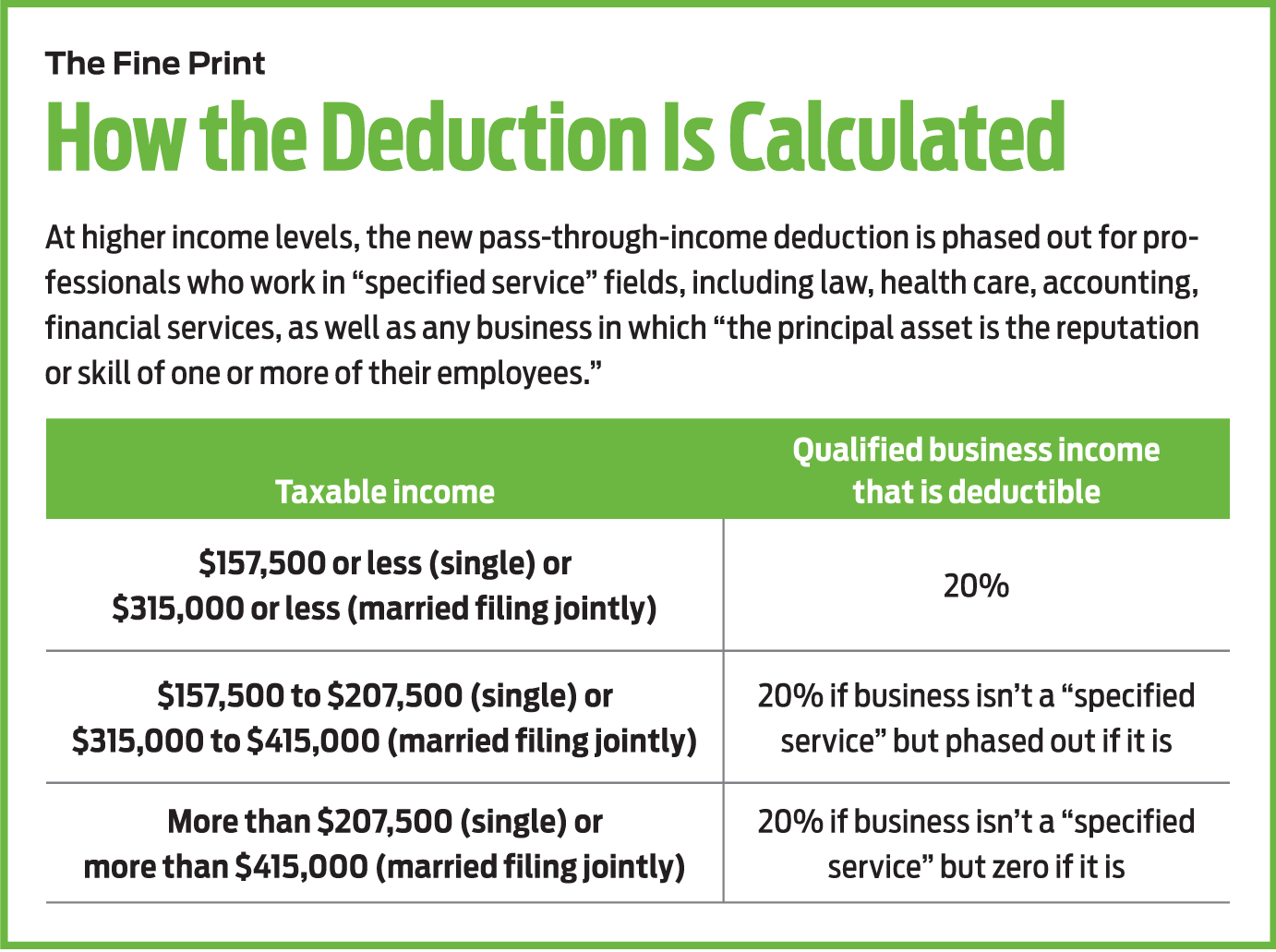Some Self-Employed Taxpayers Get a Big Break Under New Law
The new tax law allows many self-employed workers to deduct up to 20% of qualified business income.


If you’re self-employed or have a side gig, you could qualify for one of the most generous provisions in the tax overhaul enacted by Congress late last year. But if you don’t already have an accountant or tax preparer, you might need one, because this tax break is also one of the most complex provisions in the Tax Cuts and Jobs Act.
The break could benefit millions of sole proprietors, small-business owners, freelancers and gig workers, who “pass through” their business profits (or losses) to Schedule C of their individual tax returns and pay individual tax rates. Starting this year, many of these taxpayers will be allowed to deduct up to 20% of their qualified business income—net income after they’ve claimed business deductions—before they calculate their tax bill. For example, if you’re self-employed and earn $100,000 in qualified business income this year, you could be eligible to deduct $20,000. If you’re in the 24% tax bracket, that would reduce your tax bill by $4,800.
You don’t have to itemize to claim this new tax break. The deduction won’t reduce your adjusted gross income, nor will it reduce your earnings for purposes of calculating taxes for Social Security and Medicare, says Nathan Rigney, a research analyst at H&R Block’s Tax Institute. (Unlike employees who work for someone else, self-employed workers must pay the full 15.3% of self-employment taxes, although they can deduct half of the amount from their AGI.)

Sign up for Kiplinger’s Free E-Newsletters
Profit and prosper with the best of expert advice on investing, taxes, retirement, personal finance and more - straight to your e-mail.
Profit and prosper with the best of expert advice - straight to your e-mail.
Congress made this change in an effort to create tax parity between small-business owners and big corporations. The Tax Cuts and Jobs Act cut the corporate tax rate from 35% to 21% but only reduced the top personal tax rate from 39.6% to 37%. Excluding 20% of qualifying income effectively cuts the top rate from 37% to 29.6%.
Proponents of the tax cut say it will encourage self-employed people and small-business owners to invest in their businesses, thus contributing to economic growth. So far, though, that’s not happening. A survey by the National Association for the Self-Employed conducted before the tax deadline of April 17 found that 83% of its members don’t understand how the tax law will affect their business.
Who gets the deduction. The confusion is understandable because this tax break comes with more caveats than a TV ad for a prescription drug. Several factors could disqualify you for all or part of the pass-through deduction, including the amount of your business income, other sources of income and the nature of your business.
Let’s start with the income thresholds. If your total taxable income—which includes interest and dividends, as well as income reported on Form W-2, if you also have a regular job—is less than $157,500 on an individual return or $315,000 on a joint return, you’re a winner. You can deduct 20% of your qualified business income no matter what type of business you’re in. Keep in mind that the 20% deduction is limited to income from your business. For example, if a married couple who file jointly have taxable income of $150,000, and $75,000 is qualified business income, they can deduct 20% of $75,000, or $15,000.
At higher income levels, the calculation gets more complicated. In an effort to prevent affluent doctors, lawyers and, say, hedge fund managers from gaming the system, Congress created a higher standard for professionals who provide personal services. For these business owners, the deduction phases out once total taxable income exceeds $157,500, or $315,000 for married couples, and disappears once taxable income tops $207,500 for singles and $415,000 for couples.
The tax law says the higher threshold applies to professionals who work in “specified service” fields, including law, health care, accounting, performing arts, consulting, athletics and financial services, as well as any business in which “the principal asset is the reputation or skill of one or more of their employees.” (Business owners who don’t fall into the “specified services” category can take the full deduction, no matter how much taxable income they report.) That’s open to a lot of interpretation, and tax professionals are awaiting guidance from the IRS on what constitutes a “specified service.”
Ted Ma of Point Richmond, Calif., recently started his own business as a motivational speaker for corporate clients. He also works as an independent contractor for a company that sells subscription-based legal services. Ma believes his speaking business falls into the “specified service” category, but his sales job could be exempt. He’s not sure, though, and his accountant isn’t, either. Ma says he’d like to invest more in advertising and “building his brand,” but he’s reluctant to spend the money until he has a better handle on how the new tax break will affect his bottom line.
Evan Antonini, whose New York-based business provides bookkeeping and financial-management services to companies, believes she falls into the “specified service” category, but she says her taxable income (she files jointly with her husband) is low enough to qualify her for the full 20% deduction on her business income. Still, “one big contract could throw that out the window,” she says.
Lower your income. Amid this uncertainty, there are steps you can take that will increase your eligibility for the tax break. If you’re close to the cut-off, contributing to a tax-deferred retirement plan will reduce your taxable income. Self-employed people can contribute up to 20% of their net income to a SEP IRA, up to $55,000 in 2018. Another tax-saving option is a solo 401(k)—also known as an individual 401(k)—which is a retirement plan designed for self-employed people who have no employees other than a spouse. In 2018, you can contribute up to $55,000, or $61,000 if you’re 50 or older.
The tax law nearly doubled the standard deduction, but if you have a lot of deductible expenses, you may still end up itemizing. In that case, increasing your charitable contributions could also lower your taxable income below the thresholds, says Trevor McCandless, CEO of Fusion CPA, an Atlanta-based accounting firm that advises small businesses and entrepreneurs.

Get Kiplinger Today newsletter — free
Profit and prosper with the best of Kiplinger's advice on investing, taxes, retirement, personal finance and much more. Delivered daily. Enter your email in the box and click Sign Me Up.

Block joined Kiplinger in June 2012 from USA Today, where she was a reporter and personal finance columnist for more than 15 years. Prior to that, she worked for the Akron Beacon-Journal and Dow Jones Newswires. In 1993, she was a Knight-Bagehot fellow in economics and business journalism at the Columbia University Graduate School of Journalism. She has a BA in communications from Bethany College in Bethany, W.Va.
-
 How to Access Private Markets with Interval Funds
How to Access Private Markets with Interval FundsLet's explore how interval funds work — and how they're opening the doors to private market investing.
By Nicholas Pope
-
 Bouncing Back: New Tunes for Millennials Trying to Make It
Bouncing Back: New Tunes for Millennials Trying to Make ItAdele's mournful melodies kick off this generation's financial playlist, but with the right plan, Millennials can finish strong.
By Alvina Lo
-
 Trump’s Tax Cut Risks Your SNAP, Medicaid Benefits
Trump’s Tax Cut Risks Your SNAP, Medicaid BenefitsTax Cuts The GOP budget blueprint could slash lifesaving programs for millions of U.S. households.
By Gabriella Cruz-Martínez
-
 Missed Tax Day? Nearly One Million Taxpayers Still Can File and Claim Valuable Tax Refunds
Missed Tax Day? Nearly One Million Taxpayers Still Can File and Claim Valuable Tax RefundsTax Refunds As many as one million taxpayers could be missing out on a significant tax refund.
By Gabriella Cruz-Martínez
-
 Ask the Editor: Reader Questions, April 18 — Amended Returns
Ask the Editor: Reader Questions, April 18 — Amended ReturnsIn our Ask the Editor: Taxes, April 18, round-up — Joy Taylor, The Kiplinger Tax Letter Editor, answers questions on amended returns, mortgages and deductions.
By Joy Taylor
-
 First 100 Days: Trump's Impact on Your Finances
First 100 Days: Trump's Impact on Your FinancesHere are some opportunities to consider regarding investing, interest rates and tax cuts as the financial landscape shifts under the new administration.
By Daniel Razvi, Esquire
-
 Which Generation Pays the Most Tax in the US?
Which Generation Pays the Most Tax in the US?Tax Burden Polls show that most people feel like taxes are unfair. But which age group bears the brunt of the tax burden in the United States?
By Kelley R. Taylor
-
 How the Trump Harvard IRS Tax Threat Could Impact You
How the Trump Harvard IRS Tax Threat Could Impact YouTax Law Trump's latest higher education showdown raises fundamental questions that could reach beyond Harvard's nonprofit tax status.
By Kelley R. Taylor
-
 Tax Day 2025: Don’t Miss These Freebies, Food Deals and Discounts
Tax Day 2025: Don’t Miss These Freebies, Food Deals and DiscountsTax Day You can score some sweet deals on April 15 in some select restaurants like Burger King, Shake Shack, and more.
By Gabriella Cruz-Martínez
-
 Tax Time: Does Your Kid Influencer Owe Taxes?
Tax Time: Does Your Kid Influencer Owe Taxes?State Tax Some minors are making big money on social media. Here’s how to know if they need to file taxes.
By Gabriella Cruz-Martínez